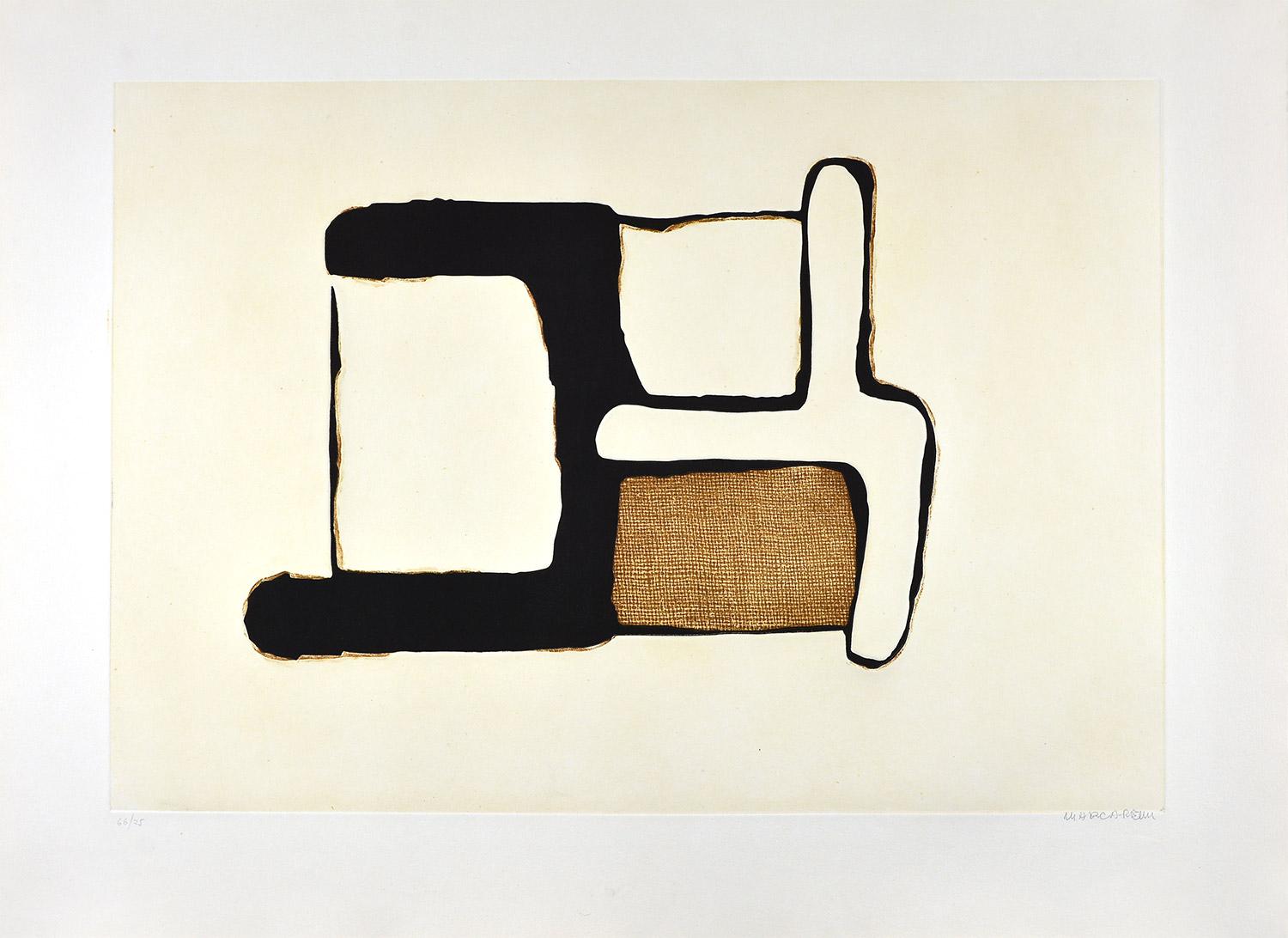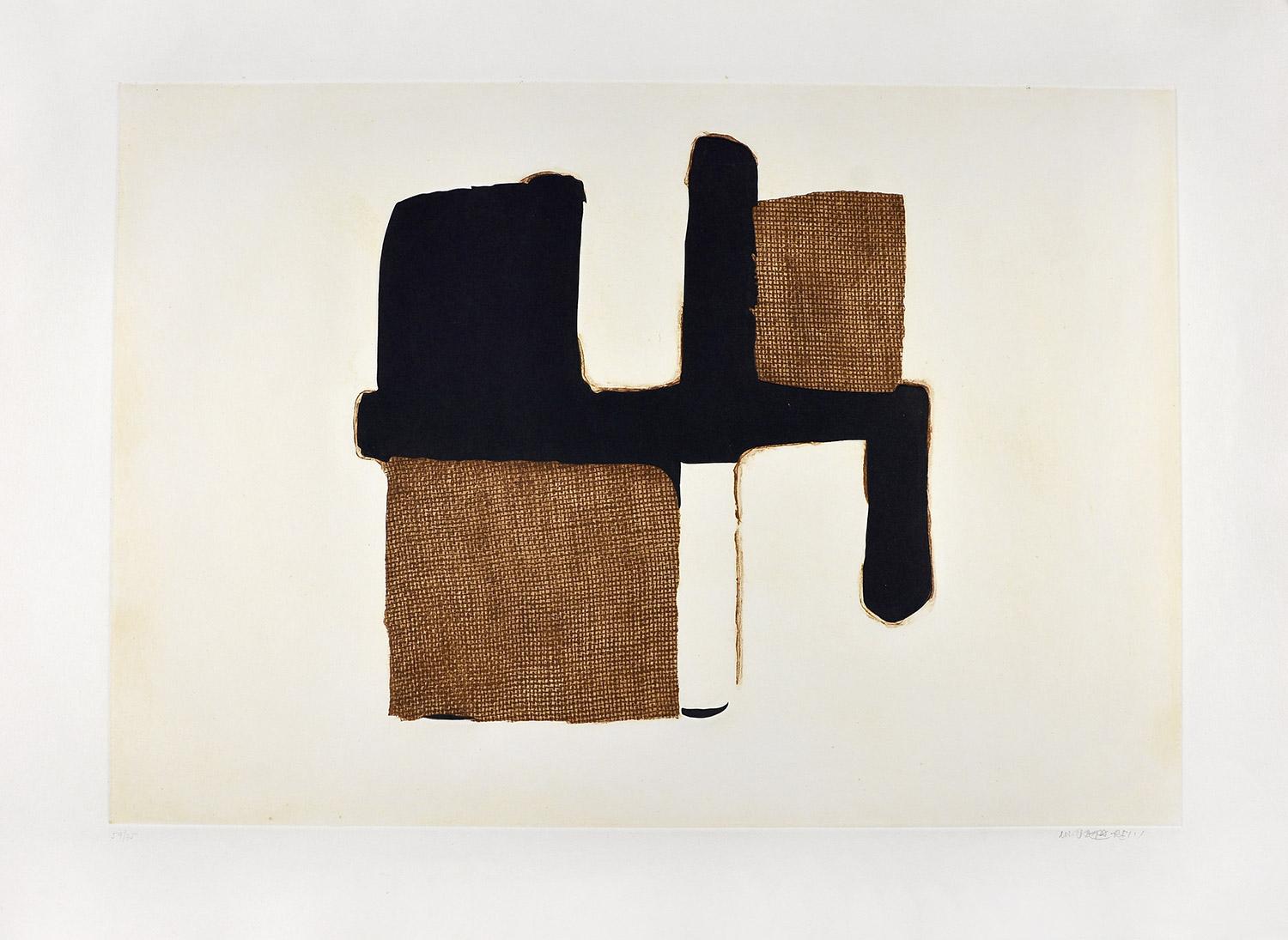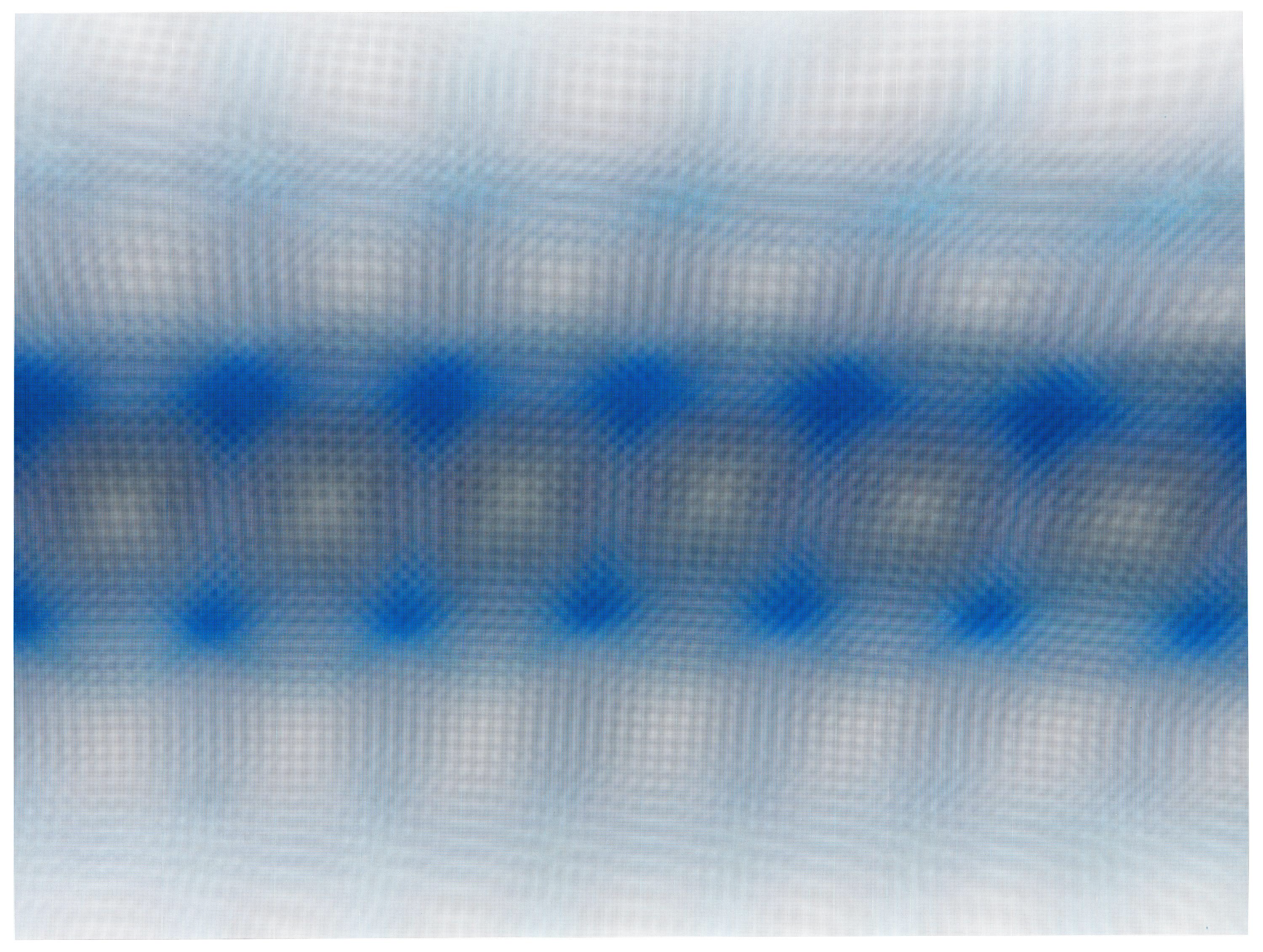Items Similar to Composition
Want more images or videos?
Request additional images or videos from the seller
Umberto MastroianniCompositionc. 1970
c. 1970
About the Item
Composition
Original carborundum engraving, c. 1970
Signed: Mastroianni in pencil lower right (see photo)
Edition: 100 (76/100) (see photo)
Printed on a heavy laid paper
Condition: Excellent
Plate size: 15 1/2 x 11 9/16 inches
Sheet size: 20 x 13 3/8 inches
Lee Marshall for the Indepenent
Saturday 22 October 2011
UMBERTO MASTROIANNI was one of Italy's leading sculptors. After the Second World War, he cornered the market in municipal monuments to the Italian Resistance - which he had participated in - but his towering, dynamic creations in steel and bronze also found a place in museums and sculpture-parks from Los Angeles to Tokyo.
Mastroianni came from one of those families that breeds talent - all the more surprising as it was based in the rural backwater of Fontana Liri, in the mozzarella-belt of southern Lazio. His father Vincenzo was a master engraver, a craft that had been handed down from father to son for generations; his mother Luisa Conte was a cousin of the American actor Richard Conte. One of her grandsons, Marcello - Umberto's nephew - would go on to play with clay in his uncle's studio; later he remembered how Umberto had once made the family a Nativity scene out of snow).
Umberto travelled to Rome as a young teenager to study at the San Marcello art school and help out his uncle Domenico in his religious sculpture studio in Via Margutta, the Roman Montmartre. Two years later he was off to Turin, where he completed his apprenticeship with the sculptor Michele Guerrisi.
Mastroianni thrived on the city's lively art scene, forming friendships with second-wave Futurists like Luigi Spazzapan, who became a sort of mentor for the younger artist. It was another painter, Filippo De Pisis, who obtained Mastroianni his first one-man show, held in Genoa in 1931.
Through the Thirties, despite his Futurist sympathies, Mastroianni stayed resolutely figurative, sculpting lifesize bronzes in a pared-back classical manner close to that of Marino Marini. It was in 1942, as Italy's war effort began to disintegrate, that he finally embraced abstraction, developing a style that the critic Cesare Brandi would later define as "Cubist-Futurist".
The dynamic fringe of both movements fascinated Mastroianni: his models were Duchamp's Nude Descending a Staircase No 2 and Boccioni's unfinished sculptural experiments. His first important public commission, the Turin Monumento ai Caduti ("Monument to the Fallen Soldier") of 1945-47, was the first of a number of such commemorative sculptures - those in Cuneo, Urbino, Cassino and Frosinone are the most significant - in which the values of the Resistance were incarnated in a solid energy of broken circles and tilting planes.
Mastroianni's neo-Futurist shift was sealed with an influential Parisian show in 1951. Later exhibitions at the Venice Biennale (where he won the sculpture prize in 1958), New York (1964), Florence (1981) and Tokyo (1989) confirmed his international reputation. Though he produced many gallery- sized works in various media - clay, marble, copper and wood - he was never happier than when given the chance to work in bronze or steel on a grand scale, as in the towering Cuneo Resistance monument (1964), "a mountain", wrote the painter, "which served to clear my mind and put those critical labels in perspective". His last work was a pair of huge steel gates for Turin's Teatro Regio opera house, inaugurated in December 1994.
The sculptor's long Turin residence ended in 1960, when he moved to Marino, in the Castelli Romani east of Rome. He set up house in a 16th-century palazzo which had once belonged to the poetess Vittoria Colonna, Michelango's muse. Towards the end of his life he himself turned to poetry; he also wrote occasional columns on art for the Rome daily Il Messaggero. In March 1987, he donated a group of 27 works to the Italian state, including a series of polychrome reliefs (they can be seen at the Galleria di arte moderna in Rome).
Umberto Mastroianni was a big man with large, eloquent hands and an emphatic way of getting his point across. In moments of creative tension he would jump into his beloved Ferrari Dino and tear around the Castelli - even after he turned 80.
Umberto Mastroianni, sculptor: born Fontana Liri, Frosinone, Italy 21 September 1910; married Ida Perlo; died Rome 25 February 1998.
UMBERTO MASTROIANNI. SELECTION OF WORK (1931 - 1996)
Mirbach Palace (show Contact)
7. 5. 2008 - 15. 6. 2008
Curator: Floriano De Santi
BIOGRAPHY IN SHORT
Umberto Mastroianni was born in Fontana Liri, an ancient village in the province Frosinone, on 21 September 1910. In the year 1924 he came to Rome, where he used to visit the atelier of his uncle Domenico and drawing courses at the Academy San Marcello. In the year 1926 he moved with his family to Turin and he improved in the “sculpting craft” in the atelier of Michele Guerrisi. In the year 1930 he was for the first time given an official award by the Ministry of Education – “Premio del Turismo” and then gradually were coming subsequent exhibitions on both - national and European level - in the year 1935 Quadrennial in Rome and the following year Biennale in Venice. Filippo De Pisis appreciated his creation a lot, mainly because he was inspired by the ancient art of sculpting, Egyptian and Hellenic sculptures.
During WWII he was recruited into the army and then he actively took part in the defence. His own experience from concrete battles for freedom he later carried over into his creation and in this way he created “poetics of the defence” which was credited to him by Giulio Carlo Argan. In Turin he met the painter Luigi Spazzapano, an independent carrier of the alternative line in comparison to the “classicism” of Casorati as well as the cultural position of the group of painters “Gruppo dei Sei” bound to the heritage of the postimpressionists.
After the liberation he advertised supranational overcoming of the Italian culture according to the “historical avant-gardes”. In the year 1951 he had his first author’s exhibition in the most famous European gallery Galerie de France in Paris. However, he received his highest award at the XXIX Biennale in Venice in 1958, when he got the prize “Grand Premio Internazionale for the art of sculpting”.
In the years 1961 – 1969 he was the head of the Academy of Arts in Bologna, where he was also the head of the department of sculpting, from Turin he moved in the year 1970 to Marino Laziale, he taught first at the Academy of Arts in Naples and later in Rome. In the year 1973 the Academy Lincei awarded him with the prize “Premio Antonio Feltrinelli” for the “high ideal and shape quality of his work, remarkable influence onto the development of the modern sculpting art in Italy and mainly for his most important work Monumento alla Resistenza di Cuneo, which is a synthesis of a strong shaping engagement and a gigantic citizen’s feeling”.
In the year 1979 the Musée d’Art Moderne de la Ville in Paris again introduced the whole sculpting creation of Mastroianni in the cycle on post-war Italian sculpting. A year later, Floriano De Santi was the curator of an overview of his chromed sculptures, drawings, wooden reliefs and carvings. The works that time exhibited in Palazzo Ducale in Urbino, stress the creative expression, which for years is the object of interest of a few specialists. In the year 1979, almost like a proof of his infinite experimental talent he prepared for the Roman opera the scenography Coro dei morti according to the literary pattern from the poet Giacomo Leopardi and the music by Goffredo Petrassi.
In the year 1993 in Arpino (in the spaces of the Palazzo Ducale Boncompagni) and in Rome (in spaces of San Salvatore in Lauro) two Mastroianni’s museums opened under the leadership of Floriano De Santi. In the year 1994 the immense artwork Cancellata was placed into the Royal theatre in Turin and Mastroianni was awarded honourable citizenship.
In the night of the 25 February 1998 after a long and hard illness, Mastroianni died in his house – museum in Marino. Seven years after his death the Museo del Corso in Rome organised an important retrospective exhibition with the title “Umberto Mastroianni, sculptor of European importance” which introduced a collection of 170 works from the years 1927-28 – 1997.
- Creator:Umberto Mastroianni (1910 - 1998, Italian)
- Creation Year:c. 1970
- Dimensions:Height: 15.5 in (39.37 cm)Width: 11.57 in (29.39 cm)
- Medium:
- Movement & Style:
- Period:
- Condition:
- Gallery Location:Fairlawn, OH
- Reference Number:
About the Seller
5.0
Recognized Seller
These prestigious sellers are industry leaders and represent the highest echelon for item quality and design.
Platinum Seller
These expertly vetted sellers are 1stDibs' most experienced sellers and are rated highest by our customers.
Established in 1978
1stDibs seller since 2013
713 sales on 1stDibs
Typical response time: 1 hour
Associations
International Fine Print Dealers Association
- ShippingRetrieving quote...Ships From: Fairlawn, OH
- Return PolicyA return for this item may be initiated within 10 days of delivery.
More From This SellerView All
- Red to Green PortalBy Richard AnuszkiewiczLocated in Fairlawn, OHRed to Green Portal Aquatint, 1979 Signed and dated in pencil lower right (see photo) Edition: 95 (84/95), see photo Provenance: U.S. Representative James A. Leach Condition: Excelle...Category
1970s Op Art Abstract Prints
MaterialsAquatint
- Rue CaulaincourtBy Louis MarcoussisLocated in Fairlawn, OHRue Caulaincourt Etching and engraving, 1931 Initialed in the plate (see photo) Edition: 77 Plate 10 from "Plaches de Salut" Published by Aux Editions Jeanne Bucher, Paris Rue Caulai...Category
1930s Cubist Abstract Prints
MaterialsEngraving, Etching
- Trees (Trees in Circle)By Louise NevelsonLocated in Fairlawn, OHTrees (Trees in Circle) Etching & drypoint with monotype inking, 1953-1955 Signed in pencil An unrecorded trial proof, printed on heavy wove proofing paper at Atelier 17, before the ...Category
1950s Abstract Landscape Prints
MaterialsDrypoint, Etching, Monotype
- Blue Rythms (Agerup 188) after the 1966 painting, Peinture.By Zao Wou-KiLocated in Fairlawn, OHBlue Ruthms (Agerup 188) after the 1966 painting, Peinture. Etching with aquatint, 1968 Signed, dated and numbered in pencil (see photos) Edition: 95 (74/95) Plate: 17 1/2 x 21 1/2" ...Category
1960s Abstract Abstract Prints
MaterialsAquatint
- BATBy Bertrand DornyLocated in Fairlawn, OHBat Embossed color aquatint and etching on Arches paper, 1976 Signed by the artist in pencil lower right (See photo) The Print Club of Cleveland stamp verso Edition: 261 The Print Cl...Category
1970s Abstract Abstract Prints
MaterialsAquatint
- Untitled (Plate 3)By Terry HaassLocated in Fairlawn, OHFrom: Happy Pentagone (6 plates) Signed and numbered in pencil Edition: 100 (37/100) Printer: Lacouriere et Frelaut Imprimeur, Paris Paper: BFK RIVES watermark on some sheets from th...Category
1970s Abstract Abstract Prints
MaterialsEtching
You May Also Like
- ANISH KAPOOR - MOIRÉ. Limited edition etching Hand signed. Contemporary, ModernBy Anish KapoorLocated in Madrid, MadridANISH KAPOOR MOIRÉ 2 Date of creation: 2015 Medium: Etching on paper Edition: 39 Size: 96 x 72.4 cm Condition: In perfect conditions, brand new Etching on paper hand signed and numbe...Category
2010s Modern Abstract Prints
MaterialsPaper, Etching
- CONRAD MARCA-RELLI Limited ed. Etching & Aquatint American Modern, ContemporaryBy Conrad Marca-Relli 1Located in Madrid, MadridConrad Marca-Relli - Composition IX Date of creation: 1977 Medium: Etching and aquatint on Gvarro paper Edition number: 66/75 Size: 56 x 76 cm Condition: In very good conditions and ...Category
1970s Modern Abstract Prints
MaterialsPaper, Etching, Aquatint
- ANISH KAPOOR - MOIRÉ. Limited edition etching Hand signed. Contemporary, ModernBy Anish KapoorLocated in Madrid, MadridANISH KAPOOR MOIRÉ 3 Date of creation: 2015 Medium: Etching on paper Edition: 39 Size: 96 x 72.4 cm Condition: In perfect conditions, brand new Etching on paper hand signed and numbe...Category
2010s Modern Abstract Prints
MaterialsPaper, Etching
- CONRAD MARCA-RELLI Limited ed. Etching & Aquatint American Modern, ContemporaryBy Conrad Marca-Relli 1Located in Madrid, MadridComposition XII Date of creation: 1977 Medium: Etching and aquatint on Gvarro paper Edition number: 46/75 Size: 56 x 76 cm Observations: Etching and aquatint on Gvarro paper hand sig...Category
1970s Modern Abstract Prints
MaterialsEtching, Aquatint
- CONRAD MARCA-RELLI Limited ed. Etching & Aquatint American Modern, ContemporaryBy Conrad Marca-Relli 1Located in Madrid, MadridConrad Marca-Relli - Composition II Date of creation: 1977 Medium: Etching and aquatint on Gvarro paper Edition number: 59/75 Size: 56 x 76 cm Condition: In very good conditions and ...Category
1970s Modern Abstract Prints
MaterialsEtching, Aquatint
- ANISH KAPOOR - MOIRÉ. Limited edition etching Hand signed. Contemporary, ModernBy Anish KapoorLocated in Madrid, MadridANISH KAPOOR MOIRÉ 4 Date of creation: 2015 Medium: Etching on paper Edition: 39 Size: 96 x 72.4 cm Condition: In perfect conditions, brand new Etching on paper hand signed and numbered by the artist on the back. This work belongs to a limited edition of only 39 copies. Edited by Paragon Press, UK. ABOUT THE ARTIST Anish Kapoor is an influential British sculptor and contemporary artist of Indian origin. He was born on March 12, 1954 in Bombay, India, into a family of Indian and Iraqi descent. Throughout his career, Kapoor has made a significant mark on the contemporary art world with his innovative and provocative work, which explores themes of form, color, space and perception. Kapoor moved to London in the 1970s to study at the prestigious Hornsey College of Art and later at the Chelsea School of Art Design. His initial artistic training was influenced by minimalism and conceptual art, but he soon developed his unique and distinctive style. One of the most notable characteristics of Kapoor's work is his focus on sculpture. He often works with unusual and challenging materials, such as wax, stone, steel and plaster, to create sculptures that challenge traditional notions of form and space. His works often take on organic and geometric forms, and are characterized by their highly polished finish and use of color, especially red and black. In the 1980s, Kapoor became famous for his series of shell-shaped sculptures known as "Queen Sculptures...Category
2010s Modern Abstract Prints
MaterialsPaper, Etching





